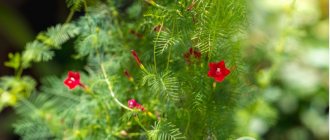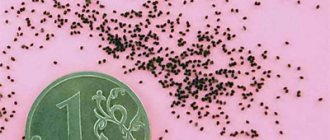Rosehip is one of the most ancient plants on earth. Before the Ice Age, it grew everywhere. This is evidenced by numerous archaeological excavations in different parts of the Earth. It was found that even primitive people used rose hips in their diet.
After global warming, natural thickets of rose hips remained in the Middle East, southern China, the Pamirs, the Himalayas and the Caucasus (high in the mountains). It also grew in North and Central America all the way to the Mexican border.
Today, rose hips grow in almost all countries of the Northern Hemisphere. It is widely used in landscape design and in the medical industry for the preparation of vitamins and restorative medicines.
This amazing plant became the progenitor of all types of roses that now exist on our planet. Moreover, one of the types of rose hips is called Rosa rugose or Rosa rugosa .
Read more about growing roses in our article “Frost-resistant roses in your garden.”
Rosehip is not only a very beautiful flowering plant, but also a very useful medicinal plant. Not only its fruits, but also other parts (leaves, bark, roots) have high medicinal properties.
This is the most unpretentious ornamental shrub that can decorate any area, because its flowering lasts from early June to mid-September. Thanks to its deep and branched root system, it is able to extract moisture from the lower horizons of the soil, so it can only be watered once a month (but very generously).
Rosehip is the best decorative crop for creating a hedge!
It quickly grows overgrown with basal shoots and is capable of creating an impenetrable barrier, the reliability of which is reinforced by numerous long thorns. High frost resistance keeps plants intact, without freezing of individual branches.
The height of the bushes reaches 2 m. You cannot climb over such a “fence” without serious scratches and injuries! But, if you plan to use medicinal fruits, you need to plant the plants away from the railway and highway, since both the leaves and berries of rose hips absorb all heavy metals and harmful substances from the surrounding air.
Therefore, it is better to create rosehip hedges away from any sources of pollution. To prevent rose hips from spreading throughout the entire area, limit its root system with old sheets of iron or slate, digging them into the ground to a depth of 50 cm.
Rosehip is a long-living plant. In one place it will grow and bloom beautifully for more than 60 years.
In this article we will talk about how to properly plant and grow rose hips in your garden, and also take a closer look at the beneficial properties of this wonderful plant.
General description of the plant
Rosehip is a shrub with erect, climbing or creeping stems from 0.15 to 10 m long. There are both deciduous and evergreen species. Most often it is a shrub with many stems up to 2-3 m high.
The root system is taproot. The main root grows to a depth of 5 meters. Most of the roots penetrate no more than 0.4 cm deep. The radius of their spread is 0.6-0.8 m.
Rose hips have arched, erect branches on which many shoots of brown-red, dark red, dark brown, black-brown color with felt pubescence are formed. The branches and shoots of many species have thorns, which can be arranged in pairs or scattered. They are thinner and softer the younger the plant. There are also species without thorns. The thorns help the shrub to stay among other plants and protect it from animals.
The leaves of rose hips are odd-pinnate, long-petiolate, arranged in a spiral on the stems. They can be green, reddish, bluish. Their edges are serrated, their shape is elliptical or round, their base is wedge-shaped, rounded or heart-shaped.
The flowers are bisexual, 1.5-10 cm in diameter. They can be solitary or collected in panicles or scutes.
Fruiting begins in the third year after planting. Rosehips are multi-nutlets of red, orange, purple color, up to 1-1.5 cm in diameter, filled with coarse, single-seeded nuts.
Rose hips ripen in August-September
Rose hips in the garden
Rosehip is a long-liver that can grow in one place for up to 50 years. Unlike the capricious garden rose, it is easy to grow. It is unpretentious, takes root well, and is not afraid of frost. Planting and care are not difficult and do not require special skills.
Growing rose hips in the garden is very advisable, since it can perform several functions at once.
Rose hips are decorative, bloom beautifully and exude a pleasant aroma. It looks impressive both in single and group plantings.
Prickly rose hips can be used to create a hedge that will protect the area from uninvited guests
Rosehip is a medicinal plant. Its fruits are rich in vitamin C, which they contain tens of times more than lemon. Other parts of the plant – leaves, roots, bark – also have medicinal properties.
Distribution of the plant in nature
About 400 varieties of rose hips are known throughout the world, mostly growing only in a certain area, and there are tens of thousands of cultivated varieties.
More than half of the species grow in Russia and neighboring countries.
The Himalayas are considered the birthplace of rose hips. Dense thickets of shrubs can often be found in the most favorable conditions for it in the Mediterranean. The culture has become more widespread in the forest part, as well as along river ravines and wet meadows, steppes and plains of the temperate zone and subtropics of the Northern Hemisphere, as well as in some mountainous areas - throughout Russia, the Caucasus, Europe and Central Asia.
The plant is not picky about soil and grows well in loamy, sunlit places of moderate humidity, so different types of rose hips are found on all continents except the Arctic - from the Arctic Circle to the American continents, Australia and New Zealand.
Variety selection
Rosehip amazes with its varietal diversity. A large number of decorative varieties with white, pink and red flowers have been bred. When choosing, you need to consider your needs. Some gardeners grow the plant for beauty, others for its edible and healthy fruits.
Rose hips can be divided into two groups:
- Large-fruited varieties with dense skin (from 4 grams or more): Apple, Oval, Yubileiny, Globus. The fruits are shaped like small apples; they can be eaten fresh and used to make jam.
- Small-fruited varieties with thin skin (up to 4 grams): Vorontsovsky 1, Rubin, Titan, Vitamin VNIVI. The fruits are oval, ideal for drying.
| Variety name | Short description | Bush height | Winter hardiness | Ripening time |
| Oval | The fruits are red, flattened, thick-skinned, sweet and juicy. It is most suitable for processing and can also be dried. | Up to 1.5 m | High | From mid-August |
| Anniversary | The flowers are beautiful, large, pink. The fruits are round, large, orange-red, sweet and sour, rich in vitamin C, suitable for jam and drying. | Up to 1.5 m | High | From mid-August |
| globe | The flowers are large. The fruits are spherical, bright red, high in vitamin C, suitable for processing (preparing jam, preserves, candied fruits). High-yielding. | Up to 1.5 m | High | From mid-August |
| Apple | The flowers and fruits are dark red, the bush is very decorative both during flowering and fruiting. The berries are large, flat-round, sweet and sour, suitable for processing. Productivity is average. | Up to 1.2 m | High | From mid-August |
| Vorontsovsky 1 | The fruits are oval-elongated, orange-red, suitable for drying, high in folic acid and vitamin C. | Up to 2 m | Average | From mid-August |
| Ruby | The flowers are small, pale pink. The fruits are round-oval, initially orange, when ripe they become dark red, sweet and sour, suitable for drying. | Up to 2.5 m | High | From mid-August |
| Vitamin VNIVI | The flowers are pale pink, small, collected in inflorescences. The fruits are oval, red-orange. | Up to 2 m | High | From the beginning of August |
| Titanium | Very decorative, the flowers are a delicate light pink shade. Fruits in clusters of 3-5 pieces, suitable for drying. | Up to 2 m | High | From the beginning of August |
Which fruit is healthier: round or oblong and can it be eaten?
The fruits of almost all types of rose hips have beneficial properties, with the exception of decorative varieties with beautiful flowers, but small and few berries.
Therefore, the elongated and spherical fruits contain a rich vitamin complex.
But round fruits are considered more valuable, since they are usually more fleshy and juicy, have a thin skin and their harvest is much more abundant. It is best to make jam from them or eat them fresh. But oblong berries are often harvested and used dried.
Landing
Before planting rose hips, you need to choose the right place, dig a hole and prepare the soil mixture. One- or two-year-old seedlings are best suited as planting material.
On a note! It is not recommended to take old bushes for planting - they take root worse.
Deadlines
Rosehip is an unpretentious plant, so it can be planted in spring, autumn and even summer. The bush that takes root best is planted in the fall - in October and November. The main thing is to have time to plant it no later than two weeks before the onset of cold weather.
Selecting a location
Rosehip loves open sunny areas with fertile soil and deep groundwater. It is best to set aside elevated places for it. Low and swampy areas are not suitable - long roots will begin to rot and the plant will die.
Planting scheme
Rosehip bushes are quite spreading, so they need to be planted at a distance of at least 150 cm from each other. When forming a hedge, this interval can be about 60-80 cm.
Questions about rose hips
Tree or shrub
Wikipedia says that Rosehip is a deciduous shrub with straight or creeping branches. Depending on natural conditions or care for the bush, it grows to different heights, but not more than 3 m .
Dog-rose fruit
Other sources also say that it is a shrub of varying heights and does not have a central trunk so that it can be classified as a tree.
Useful features
Rose hips contain many vitamins and other beneficial substances. And therefore the plant has many features :
- The fruits are used to make teas, pastes, jams, compotes, sweets and much more.
- Jam is made from Rosehip petals
- In Slovenia, the fruits are added to wines and give them a special taste.
- In the Caucasus, young shoots were eaten, and young leaf blades were brewed into tea .
- Pharmacological factories make various vitamins, syrups, and extracts .
Care
The unpretentious rosehip requires standard care: watering, fertilizing, pruning, protection from diseases and pests.
Watering
Rosehip tolerates drought well, but in dry times it needs to be watered. In this case, you need to be guided by the rule that it is better to underfill water than to overfill it.
In the first year after planting, the plant needs abundant and frequent watering. In dry, hot weather, 2-3 buckets of water should be poured under a young bush, and up to 5 buckets under a fruit-bearing bush. In total, it is watered 3-4 times during the season.
Top dressing
Gooseberry breeding
From the second year, rose hips need to be fed - nitrogen fertilizers must be applied. Fertilizing is carried out three times - in early spring, in June and July (when rapid shoot growth occurs), and in September.
Then, every three years, 3 kg of compost or humus should be added to each bush, after which the soil should be watered, loosened and mulched.
Trimming
From the age of three, rose hips require pruning. Remove weak, shriveled, broken, diseased stems and those lying on the ground. Root shoots that are not planned to be used for propagation are also removed. From this same age, you can begin to form a bush - giving it the desired shape.
The plant is pruned at the very beginning of spring, when sap flow has not yet begun. Rose hips do not tolerate autumn pruning well, so it is not recommended at this time of year, especially in regions with cold climates.
When pruning, you need to leave strong shoots of different ages.
It is necessary to keep branches that are located at the same distance from each other. They are cut to 60-100 cm.
A five-year-old bush should have 15-20 branches of different ages evenly spaced from each other.
Shoots seven years old and older bear very little fruit, so it is advisable to get rid of them to allow faster growth of young branches.
Attention! You should not get too carried away with pruning the rose hips, otherwise in the spring the bush will produce a lot of young shoots that will not bear fruit.
Wintering
There is no need to cover rose hips for the winter, since they are highly frost-resistant and can tolerate frosts below 40 degrees.
Shelter may be required for young bushes or if a very frosty winter is expected. To do this, the tree trunk circle is sprinkled with leaves or peat, and the shoots are tied, bent to the ground and covered with spruce branches or non-woven material.
Disease and pest control
Rose hips are resistant to diseases and pests, but this does not exclude attacks by parasitic insects and the development of diseases.
Pests such as sawfly, spider mites, aphids, cicadas and others may appear on bushes. They are treated with insecticides. Usually 2-3 sprayings with an interval of 7 days are enough.
Of the diseases, the greatest danger to rose hips is powdery mildew and rust. To combat powdery mildew, the plant is treated with fungicides or colloidal sulfur. To prevent these diseases, it is recommended to apply potash fertilizers under the bush.
Pests and diseases of rose hips
This crop is not resistant to diseases or pests. The following pests most often settle on it: sawflies, aphids, leafhoppers, slobbering pennies, spider mites, leaf rollers, bronze beetles and deer beetles.
Sawfly larvae
The larvae of white-banded and descending sawflies gnaw four-centimeter-long passages in young shoots, because of this the stems become dark and dry out. To get rid of such larvae, you need to use insecticidal or pesticide preparations. In autumn, the soil near the bush must be dug up; in this case, the false caterpillars of this pest that appear on the surface will freeze, and the affected stems should be cut off and destroyed before the larvae emerge.
Fruit caterpillars
Young foliage and stems of the plant can be damaged by caterpillars of the fruit moth and 3 different species of roseate leaf roller. If there are few caterpillars, they are removed from the bush by hand. In the spring, before the buds open, the plant must be sprayed with a solution of a pesticide preparation.
Spider mites
Cellular sap from the foliage and stems of shrubs is sucked by spider mites, which are sucking insects. Also, together with aphids, they are the main carriers of viral diseases, for which no effective cure has been found to date. This pest settles on the bush during prolonged drought, especially if it has not been watered for a long time. If you wish, you can try to drive away the ticks; to do this, you need to spray the underside of the leaf blades of the bush with cold water 3 or 4 times a day. And in order to get rid of them quickly and effectively, you can use an acaricide.
Slobbery Penny
On the underside of the plates, as well as in the leaf sinuses, there is a slobbering pennix. This sucking pest feeds on cell sap and secretes a foamy substance. If you touch an insect, it quickly jumps out of the foam and tries to hide. To get rid of such a pest, the bush is treated with an insecticide solution.
Rose leafhopper
The rose hips can be very damaged by the rose hiphopper, which produces 2 or 3 generations per season. Because of it, many white dots appear on the surface of the foliage, the plates become like marble and lose their attractive appearance. After a while they turn yellow and fly away prematurely. To get rid of such a harmful insect, it is necessary to treat the bush and the surface of the area with an insecticide solution 2 or 3 times, and the interval between procedures should be 10–12 days.
rose aphid
Rose hips settle in large colonies on rose hips; they are found on buds, flower stalks and on the underside of leaf blades. Aphids feed on plant sap and transmit viral diseases. In 1 year, this pest can produce more than 10 generations. Preventive treatment is carried out at the beginning of the spring period, for this purpose a solution of a contact insecticide is used. Subsequent spraying can be carried out using a solution of Actellik, Antio, Karbofos, Rogor and other means of similar action.
Deer beetles and bronze beetles
Bronze beetles and stag beetles gnaw out the pistils and stamens in flowers, and also eat the petals. Bushes with light-colored flowers are especially popular among such pests. The beetles are collected early in the morning, at which time they sit, practically motionless. Collected insects must be burned.
Powdery mildew
Most often, this shrub suffers from the following diseases: powdery mildew, black spot, rust, chlorosis and downy mildew.
To get rid of powdery mildew, you need to spray the plant with a suspension of colloidal sulfur (1%) or another fungicide. To make rose hips more resistant to powdery mildew and other diseases, it should be fed with fertilizers containing potassium.
Black spot
In the second half of summer, brown-black spots may form on the petioles and foliage - these are symptoms of black spot infection. If the rosehip is very badly affected, its foliage becomes dark, dries out and flies off. In order to prevent further development of spotting, all infected leaf blades and stems must be removed and destroyed. Under the bushes, the soil is dug up with the formation turnover. In autumn and spring, the plant should be sprayed with insecticidal preparations.
Rust
If a bush is affected by rust, then on the underside of its foliage you can find a large number of dusty spores and small yellow-orange pads. As the disease progresses, deformation of stems, flowers and shoots, as well as drying out of leaf plates, is observed. Cut out and destroy the affected parts of the plant, and dig up the soil under the bush. Before covering the rosehip for the winter, it must be treated with a preparation containing copper, for example, copper sulfate.
Chlorosis
If yellow or white spots form on the surface of the leaf blades, this means that the bush is sick with chlorosis. It develops due to a deficiency of boron, manganese, magnesium, zinc, iron or other substances needed by rose hips. For example, if it lacks iron, then a chlorotic color appears on the entire leaf blade, except for large veins, while chlorosis first affects the apical young leaves. If there is a lack of zinc, the chlorotic color spreads along the edge of the leaf blade, while the color of the leaf does not change along the lateral and central veins. With magnesium deficiency, leaf blades turn yellow and die, but the color of the veins remains green. If a plant does not have enough boron, then the tissues of young leaf blades thicken, and they also turn pale and become fragile. Find out why chlorosis developed, and then add the necessary element to the soil. If desired, you can feed the plant with the necessary element through the foliage using the foliar method.
The greatest danger to this crop is downy mildew (downy mildew). The development of this disease is observed in rainy and hot weather. To combat it, fungicides and agricultural practices are used.
Pests of roses and rose hips
Reproduction
Rose hips can be propagated in the following ways:
- cuttings;
- offspring;
- layering;
- dividing the bush;
- seeds.
Scheme of propagation by cuttings
When choosing a breeding method, you should take into account some points:
- It is recommended to root rosehip cuttings in a peat-sand mixture prepared in a ratio of 1 to 3.
- A reliable and simple way is propagation by offspring (root shoots). In spring or autumn, they need to be dug up, separated from the mother bush and immediately transplanted to a permanent place. With this method, the characteristics of the variety are completely preserved.
- When propagated by seeds, some of the properties of the mother bush are lost. Therefore, this method is not suitable if you need to get an identical plant.
- Berries for seeds should be picked slightly unripe. The fact is that the seed shell at this time is quite soft and their germination rate is higher. In mid-autumn they are sown in the ground to a depth of 2-3 cm at a distance of 1.5 cm from each other. Then water abundantly and mulch with sawdust. Rosehip seeds germinate quite difficult. The first shoots will appear in the spring of next year.
- Layers are obtained from arcuate or horizontal shoots. They need to be bent to the ground and buried. The soil in this place should always be moist.
- Rose hips are easy to propagate by dividing the bush. Plants 5-6 years old are best. The bush is dug up, the root is divided into 3-4 parts, at least 2 sprouts should remain on each of them.
Properties of rosehip: harm and benefit
Useful properties of rose hips
More types of rose hips have a lot of vitamin C in their fruits. Lemons have 50 times less of this vitamin, black currants have 10 times less, and fir, spruce, juniper and pine needles have 60–70 times less compared to with rose hips. Begger's rose hips are leaders in vitamin C content. These fruits also contain vitamins B1, B2, B6, E, K, PP, carotene, tannins and coloring substances, malic and citric acids, sugars, phytoncides, essential oils, as well as potassium , magnesium, phosphorus, iron, calcium, copper, chromium, cobalt, molybdenum and manganese. The composition of the flowers of this plant includes essential oil, organic acids, glycosides (bitters and saponins), sugars, fatty oils, flavonoids, tannins, wax, ascorbic acid, anthocyanins (peonidin, cyanidin, peonin). The leader in essential oil content are the petals of the rugosa rosehip.
Rosehip oil has an antibacterial, anti-inflammatory and firming effect. It activates regeneration processes in injured tissues and mucous membranes. In this regard, it is widely used for cracks, dermatoses, trophic ulcers and abrasions. In addition to vitamin C, the foliage contains catechins, flavonoids, tannins, phenol carbonic acids and their derivatives. Essential oil was found in the foliage of the blood-red rosehip, and the composition of the leaf blades of the May rosehip includes polysaccharides and carotenoids. The branches contain saponins, catechins, vitamin P, flavonoids, the bark contains sorbitol, the roots contain tannins, catechins, flavonoids, triterpenoids.
The fruits help improve metabolic processes in the body and cleanse the circulatory system. They are recommended for use in cases of anemia, scurvy and diseases of the kidneys, liver and bladder. They are used as a tonic, general strengthening agent, enhancing the body's resistance to infectious diseases and weakening the development of atherosclerosis. To prepare it, you need to combine half a liter of water and 2 large spoons of crushed fruits. The mixture is allowed to simmer for a quarter of an hour over low heat. Then the broth is well wrapped and in this form it should stand all night; in the morning it is filtered. Drink throughout the day instead of tea, mixing with honey.
A decoction prepared from fruits and roots has a multivitamin, choleretic and mild diuretic effect, and it can also lower blood pressure. It helps improve appetite and the production of red blood cells, and also strengthens the walls of blood vessels. The juice helps normalize the functioning of the kidneys, liver and stomach, improves resistance to infections, helps activate metabolic processes and stimulate sexual activity, cleanses the body of toxins, normalizes blood circulation, improves memory, and eliminates pain in the head. Juice is a powerful antioxidant, and it also helps to quickly quench thirst.
"Live healthy!" Rose hips - beneficial properties.
Harm
People with high blood pressure should not use alcohol tincture of rosehip. At the same time, the use of water infusions of rose hips is contraindicated for hypotensive patients. People with blood circulation disorders should not take rose hips.
If products made from rosehip are used for a very long time, this will negatively affect the condition of the liver, because they help inhibit the secretion of bile. The decoction is contraindicated for chronic constipation. All products made from this plant are prohibited for use by people prone to blood clots. Heart patients also need to be careful; with endocarditis and other diseases, such drugs taken in large quantities contribute to the development of complications. If you have dermatological problems, you should consult your doctor before consuming rose hips.
Rootstock for roses
Typically, grafted roses are preferred by gardeners in the northern regions. Rosehip is considered the best rootstock for them. Plants intended for this purpose can be purchased or grown on your own site.
The dog rose, which does not produce shoots, is best suited as a rootstock. It is grown from seeds, which are obtained from unripe fruits. Before sowing, they should be kept in a container with damp sand in a cool place (4-6 °C). To prevent moisture from evaporating, they are covered with glass. Once a week, the mixture of sand and seeds is mixed and, if necessary, moistened. If they are collected at the beginning of the reddening of the berries, they can be sown without preparation in open ground to a depth of 1-2 cm. In the spring, about a fifth of the seeds will sprout. When 2-3 leaves appear, the seedlings dive: the distance between the shoots is 8 cm, between the rows - 15 cm. Standard care: watering, fertilizing, weeding, loosening, protection from diseases. In the fall they are transferred to a nursery. With good care, in early September the rootstock is ready for eye grafting. For standard roses, the rootstock is grown for several years.
Grafting a rose onto a rosehip
Types and varieties of rose hips
Today, a classification of rose hips is used, which divides the genus into 4 subgenera: 3 subgenera are small, they include 1 or 2 species that stand out from the general system, while the fourth is the subgenus Rose, which contains 10 sections and 135 species. Below we will describe in detail the varieties and species that are most popular among gardeners.
Alpine rose hips (Rosa alpina), or drooping rose hips (Rosa pendulina)
Under natural conditions it is found in the mountains of central Europe. The height of this shrub is no more than 100 cm, it has no thorns. Large flowers of rich color are located on long stalks. After the petals fly around, the flowers droop immediately. Long spindle-shaped dark red fruits hang on the bush like earrings. There are long glandular bristles on the surface of the fruits and peduncles, which makes the rosehip look very original and impressive.
May rose hips (Rosa cinnamomea), or cinnamon rose hips (Rosa majalis)
This species is widespread in the European part of Russia and Ukraine. The flowering of such a shrub is observed in May–June, at which time many large rich pink or pinkish flowers open on it. This species is quite variable, so its height can reach 250–300 cm or only 100 cm, while such rose hips form sparse thickets that occupy quite large areas. A distinctive feature of this plant is the thin paired thorns located on the flowering stems, and the bases of their stems are densely covered with needle-like small thorns. For group plantings, it is recommended to use the double winter-hardy form of this species, the flowers of which are pink-purple.
Rosehip (Rosa acicularis)
This plant is found naturally in the northern regions of Europe, America and Asia, and it can grow in groups or singly. The height of such a bush can vary from 100 to 200 centimeters. The stems are densely covered with many thin spines and arched bristles. Large flowers can be single or collected in 2 or 3 pieces; they have a dark pink or pink color. The red fruits are oblong in shape. This species is winter-hardy and has comparative shade tolerance; it adapts perfectly to city conditions. It is recommended for creating hedges, and is also used as a rootstock for cultivated varieties.
Rosehip rugosa (Rosa rugosa)
In nature, this species is found in Northern China, Korea and the Far East; it prefers to grow in the thickets of coastal meadows and sea coasts. The height of such a bush is about 250 centimeters. The leaf blades are heavily wrinkled, sometimes shiny. The leaves consist of 5 to 9 leaflets, on the underside of which there is greenish-gray pubescence. The inflorescences consist of 3–8 fragrant flowers, which can also be single. The flowers reach 6–12 centimeters in diameter. Depending on the variety, they can be simple or double; the number of petals on 1 flower can reach 5–150, while their color can be pink and white. Flowering continues throughout the summer; therefore, flowers, buds and fruits may be present on the bush at the same time. The following varieties are most popular among gardeners:
- Pink Grootendorst . The height of the bush is about 150 centimeters. The crown shape is spreading-pyramidal. Wrinkled glossy leaf plates have a greenish color. The densely double flowers are light pink in color and can reach 30–40 mm in diameter. The edges of the petals are carved. The inflorescences are similar in appearance to bouquets of carnations.
- Grootendorst Suprem . The color of the double flowers is dark crimson.
- Conrad Ferdinand Meyer . This plant blooms 2 times per season. The densely double fragrant flowers have a rich pink-silver color.
- Hanza . Double fragrant flowers reach 8–10 centimeters in diameter. Their color is purple-red.
- Agnes . The fragrant double flowers have a diameter of 7 to 8 centimeters, they are colored creamy yellow, with a darker center.
- Georges Quin . Very fragrant semi-double large flowers are cup-shaped and dark red in color.
Rose hip (Rosa spinosissima), or rose hip (Rosa pimpinellifolia)
In nature, this species can be found in the Caucasus, Western and Eastern Siberia, the European part of Russia, Crimea, Western Europe and Central Asia. This rosehip prefers to grow in hollows, forests, forest clearings and edges, and on lime deposits. This shrub is not very large, but incredibly prickly; thin thorns are located on the stems and on the petioles of the leaf blades. The leaves are small, but very elegant; in summer they are green, and in autumn their color changes to purple. The diameter of single flowers is about 50 mm, they can be painted pale yellow or white. The black, spherical fruits reach about 15 mm in diameter. The species is winter-hardy, does not have high demands on soil, adapts well to urban conditions and has a large number of cultural variations and forms. Popular varieties:
- Golden Wings . The height of the bush varies from 150 to 180 cm. Semi-double or simple flowers have a diameter of 50–60 mm and a yellowish color.
- Frühlingsdaft . The height of the bush is about 200 cm. Fragrant peach-colored flowers are single or collected in inflorescences. The stems are brown-red and spiny.
- Frühlingsmorgen . The simple yellowish flowers are very fragrant. The petals have a pink edging.
- Karl Foerster . Large, double white flowers have a high center and a faint scent.
- Prairie Youres . Semi-double large flowers have a pinkish color.
- Schloss Seutlitz . Semi-double creamy-yellow flowers reach 70–80 mm in diameter and have a subtle scent.
Dog rose (Rosa canina), or common rose hip
In nature, this species is found in Western Asia, Central and Southern Europe and North Africa. It prefers to grow in small groups or alone along ravines, on forest edges, in thickets of bushes and on river banks. The height of the bush is about 300 cm. The arched spreading branches have curved strong thorns. The composition of the not very large leaf plates includes from 5 to 7 leaves with serrated edges of a pale gray or light green color. Multi-flowered inflorescences consist of pinkish flowers five centimeters in diameter. The rich red smooth fruits have a round or elongated oval shape and a two-centimeter diameter. Has average frost resistance. This species is considered the best for rootstocks for varietal roses.
Rose hip (Rosa rubiginosa), or rusty rose hip
This species is native to Western Europe. This plant prefers to grow on the edges of forests, in thickets of bushes, in ravines and on rocky slopes. This multi-stemmed, densely branched shrub reaches a height of about 50 cm. Its crown is compact, and its prickly thorns are hook-shaped. The odd-pinnate leaf blades include from 5 to 7 leaflets, their front surface is slightly pubescent, and the back surface is glandular and rusty in color. Pink or red flowers of three centimeters in diameter can be semi-double or simple, single or part of lush corymbose inflorescences. The hemispherical fruits are red in color.
French rose hip (Rosa gallica)
This upright growing shrub reaches a height of 50 centimeters. The length of the leaf plates is about 12.5 centimeters, they consist of 3–5 large leathery leaves of a dark green color, their underside is painted in a lighter color, and it is also covered with glandular pubescence. Large flowers can be double or simple, they are 2-3 pieces in an inflorescence or can be single. Flowers can be colored in various shades from rich red to dark pink. The diameter of the spherical fruits is about 15 mm. This species is quite frost-resistant, but when cultivated in mid-latitudes it can suffer from severe frost. Garden forms:
- Medicinal . The bush is very similar to the main species, but its flowers are double.
- Thornless . Double flowers. This plant has no thorns at all.
- Changeable . On one flower, the color of the petals varies from dark purple in the middle to dark pink-red on the outer petals.
- Dwarf . The miniature bush is decorated with simple red flowers.
- Brilliant . Single or semi-double flowers are carmine-colored.
- Pubescent . The color of the flowers is red-purple. The surface of the pedicels, sepals, rounded leaves and stems is densely covered with bristles.
- Agata . Double flowers of purple color are smaller than those of the main species.
The most popular varieties of this type are:
- Complicate . The simple, faintly scented flowers are deep pink and have a white center. Their diameter is about 10 centimeters.
- Versicolor . Pinkish semi-double flowers have a very weak aroma, their diameter varies from 8 to 10 centimeters. On the surface of the flowers there are specks and streaks of a more saturated shade than the main color. Matte leaf plates are painted greenish.
Rose hip (Rosa glauca), or red rose hip
This park shrub is very impressive. In nature, it can be found in the mountains of Asia Minor, Southeast and Central Europe. The height of the bush varies from 200 to 300 cm. Thin thorns can be straight or slightly curved. The leaf blades contain from 7 to 9 elliptical leaves. The stems, leaves and stipules are covered with a light blue coating with a violet-red tint. Rich pink flowers reach 35 mm in diameter; they can be single or collected in inflorescences of three. The round cherry-colored fruits reach 15 mm in diameter. The species is resistant to drought and frost, it adapts well to city conditions, and can also be grown on calcareous soil. In the form of flora pleno, double flowers are painted in a lighter color shade, which look impressive against the background of foliage.
In addition to these species, gardeners grow such as: white rosehip, Bourbon rosehip, stinking rosehip, or yellow rosehip, Damascus rosehip, Daurian rosehip, Chinese rosehip, Kokand rosehip, Maksimovich rosehip, multifloral rosehip, moss rosehip, musk rosehip, Portland rosehip, centipelas rosehip, apple rosehip, or hairy rosehip, Elena rosehip, etc.
varietal rose hips, varieties that can be grown in cold winters
Adviсe
Tip 1
Rosehip is a cross-pollinated plant. This means that one plant is not enough if you plan to grow fruit. There should be at least two bushes on the site.
Tip 2
The powerful root system of rose hips can quickly grow and cover a fairly large area, which leads to displacement of neighbors. It is important to control this process. Since the bulk of the roots are located at a shallow depth, to limit their spread it is enough to dig pieces of slate to a depth of about 30 cm.
Harvesting rose hips
Harvesting can be considered one of the most interesting stages. This bush contains a large number of needles. For safety, it is better to protect your body with durable clothing and your hands with gloves made of thick fabric.
Tea with rosehip
When the fruit has turned orange-red and red, you can begin to collect it. This stage usually lasts from August to October. During this work, you must remember the following points:
- Rose hips in the fall must be picked before frost, otherwise a lot of vitamins will be lost.
- Since rose hips in a dacha or permanent plot do not bear fruit at the same time, it is better not to collect them at the same time. If this point is not observed, some fruits will be green, while others will be overripe.
Rosehip in landscape design
In addition to hedges, rose hips can be planted in group compositions with other trees and shrubs. For this purpose, the landing rules remain the same as described above. Only the distance between plants changes.
If you have a small open area on your property, you can plant a rounded rosehip hedge around it. Inside such a fence you can make a resting place in the form of a gazebo or a children's corner with a swing and a sandbox.
Finally, rose hips can simply be planted in a flower garden. For example, you can plant any flowers around a low bush. In any case, this composition will look advantageous.
Hedge
Rosehip fencing will grow for decades without much maintenance. It is important to plant correctly and trim occasionally. Let's look at how to plant rose hips for a hedge and what needs to be done to make them please with their appearance and bear fruit.
Rules for planting hedges
Rosehip seedlings should be planted in April-May, before the leaves begin to bloom, or in October. Wanting to quickly get a living fence, two- and three-year-old plants are planted. To obtain a dense hedge, the bushes are planted in two rows.
Laying a fence consists of several important points:
- Before landing, a plan is drawn up. The number of required bushes is calculated.
- A cord/rope is pulled at the selected location - this will help create an even line when digging planting holes.
- The holes are made in increments of 60–80 cm. With a checkerboard/double-row arrangement, the planting density is calculated according to the following scheme: 5 pieces per linear meter. The depth of each hole is 40–50 cm.
- To accelerate growth, the soil is flavored with compost and mineral fertilizers. Place 1 tbsp in each hole. l. potassium sulfate, a handful of superphosphate.
- Before planting, the root system of each seedling is shortened to 15–20 cm. For better survival, the roots are dipped for 20–30 minutes in any growth stimulator (Kornevin, Epin, Zircon, Radifarm, Ribav, Kornerost, etc.).
- During planting, you need to deepen the root collar. It should go 5–6 cm underground.
- The final stage is abundant watering. 10 liters of water are poured under each planted bush (in two doses).
Many varieties of rose hips actively produce root shoots that extend 80-120 cm from the mother bush. Restriction helps prevent “spreading.” Old slate, scraps of corrugated board, and thick plastic are dug in along the edge of the planting.
Hedge care
Rosehip is unpretentious and grows well without much labor. Care instructions consist of 3 points.
- In the first year, weeding may be required, if the summer is dry - watering.
- In the second year, a formative haircut is performed. This moment is important for creating bushiness. Each shoot is stopped by one third. Such a haircut stimulates the activity of the lateral buds, the bush gains volume and does not stretch into the trunk.
- Subsequent activities include cutting. It is held once every 1–2 years in the fall. It is more convenient to do this in October, after the end of leaf fall. In mature plantings, dry, old branches are removed.
For rejuvenation, root shoots are left (2-3 pieces per bush). When cutting rosehip plantings, a trapezoidal or rectangular shape is usually formed.











